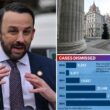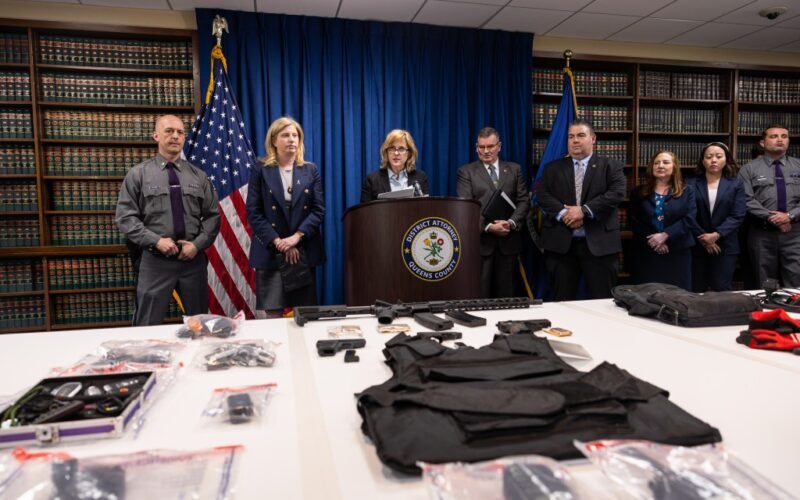A massive and sophisticated car theft ring based in Queens that sprawled across the U.S. has been uncovered, with 20 people indicted after a years-long investigation, Queens District Attorney Melinda Katz said Thursday.
The “massive criminal ecosystem,” which involved individuals who teamed up to steal, broker and sell the stolen vehicles using high-tech as well as traditional methods, is “one of the biggest auto theft rings that we have seen in the last decade,” Katz said at a press conference announcing the takedown.
Of the 20 people indicted, 14 are facing the top charge of criminal enterprise, which carries a sentence of up to 25 years in prison. The other individuals are variously charged with possession of stolen property, grand larceny and conspiracy, and two people are charged with weapons possession after investigators uncovered four illegal firearms in connection with the case.
The three-year investigation involving the Queens D.A.’s Office, the NYPD, state police and other agencies that led to the takedown was dubbed Operation Hellcat by police, “because it began with a pattern of thefts of Dodge Hellcats, traditionally identified by their high horsepower and noise to attract attention,” Katz said.
“This was a multistate, multimillion-dollar auto theft operation,” Police Commissioner Jessica Tisch said at the press conference. “It’s important to note these were not high-end luxury cars. This crew targeted regular vehicles driven by everyday New Yorkers who relied on them to get to work, to take their kids to school and just to live their lives.”
Ultimately, the crooks stole 38 Acuras, 24 Hondas, 23 BMWs, 20 Dodges, three Land Rovers and several others.
Wednesday, dozens of police officers in full protective gear, along with snipers, drones and a robot dog could be seen surrounding a home in Howard Beach in connection with the case, PIX11 reported. Cops later arrested a man wearing only his underwear and seized two vehicles, a Dodge Charger and a BMW sedan, according to PIX11.

“What started as a case against a motorcycle thief soon uncovered a full-fledged criminal enterprise responsible for stealing and trafficking thousands of vehicles annually, worth tens of millions of dollars,” Tisch said. “At the heart of this operation was a career thief who recruited, trained and led a steal crew that operated with precision, transitioning from motorcycles to cars. The crew began with simple driveway steals, opportunistically breaking into open vehicles. But, as the operation evolved, so did their methods.”
The crew of car thieves used a range of old-school and high-tech methods to break into and swipe the cars, ranging from screwdrivers to tracking-device disablers and electronic car fobs that allowed them to reprogram the keys and drive away in under 90 seconds, Katz said.
“After this group stole the cars, a second set of specialized defendants took over,” Katz continued. “Two of the defendants acted as brokers for the auto theft ring. They coordinated with the thieves to sell the cars on the black market, typically soon after the thefts, in exchange for a fee. These defendants used social media, Facebook, Instagram, Telegram, to advertise the stolen vehicles.”

“This was a sophisticated criminal enterprise with defined roles and a clear hierarchy,” Tisch added. “At the center was a nine person ‘steal crew,’ the ones physically breaking into the cars, reprogramming key fobs and driving them away. They were connected to two brokers — middlemen who took orders, some from out of state, including Tennessee, down to the make, the model and even the color of the vehicle. Then there were the sellers, who altered VINs, forged paperwork and resold the vehicles. Finally, the buyers who would pay for the stolen vehicle and arrange for its transport,” Tisch explained.
Of 126 cars allegedly stolen by this group, 44 were purchased by undercover law officers.

So far, police have arrested 16 of the individuals involved. Two others are planning to surrender in the coming days and two remain at large.
“I have a message to the buyers of these vehicles,” Katz said. “If it’s too good to be true, it probably is.”








